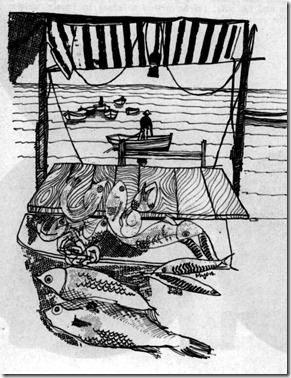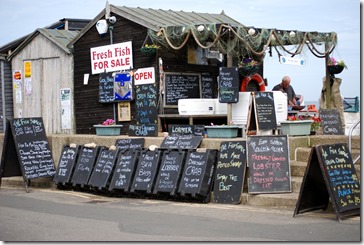Buying fish is like any other fresh food. You either know what you want and how it should look, or you have to rely on the fishmonger to tell you. This latter has been known to give rise to problems. First time I tried a fish stall after my return to the UK I was fobbed off with a bit of haddock that was a long way from its “Fresh” label. But if you try to take the advice of those in the know you will soon find people you can trust, be they fishermen, stallholders or shop assistants. And what a wealth of fish and seafood we can still find! We really don‘t know how lucky we are.
Because something is good for you, it doesn’t mean you can’t enjoy it. Fish is wonderful. It is nourishing, full of health-giving oils and such, marvellous for the cholesterol levels (unless deep fried in batter) and most versatile. Between the devil (the dreaded supermarkets we all complain about) and the deep blue sea close at hand there is still plenty of fish to be had. For me, one of the greatest dishes in the world is a fresh Dover sole (at its best one day after being caught) simply grilled with a little melted butter brushed over it, served with a squeeze of lemon juice. Scollops! Fantastic – seared quickly on both sides and served with some sweet-cure back bacon.
Moules Marinière –Brancaster Mussels cooked in white wine – yumsville. I could go on, but instead I shall give you two recipes to enjoy. The first has a hint of Morocco about it, the second a slight French connection.
Enjoy!
Baked Fish – Moroccan Style
You will need a heavy baking dish for this. Oblong ideally, about 30 cms x 20 cms, and one you can cover with lid or foil.
Ingredients for six servings
1½ kg / 3.3 lb firm white fish fillets
Juice of ½ lemon
3 medium-large garlic cloves, peeled and finely chopped
1 kg / 2.2 lb of red, ripe fresh tomatoes (or canned)
1 tsp sugar
250 g / 9 oz onions, peeled and finely sliced
2 tbsp almond flakes
1½ tbsp raisins, washed and patted dry
Olive oil
Salt and pepper
Garnish:
Bunch of parsley
1 lemon, sliced
Method
1. Heat the oven to 200ºC (400ºF, gas 6).
2. In a shallow bowl whisk together 2 tbsp olive oil, salt, pepper and lemon juice.
3. Dip the fish fillets into the oil mixture and cover each one all over.
4. Make one layer of the fish in a heavy baking dish.
5. Cover the baking dish and bake in the centre of the hot oven for about 15 minutes or until the fish is cooked nicely through (don’t let it get dry!) Set aside and keep warm.
6. While the fish is cooking, fry the garlic in 2 tbsp of oil. When it begins to go a golden colour, add the tomatoes and a teaspoon of sugar.
7. Cook on a low heat for 15-20 minutes or until the tomato mixture is nice and thick.
8. While you are doing this, take another frying pan and cook the onions in 3 tbsp of olive oil until golden at the edges.
9. Add the almonds and raisins and fry until the almonds colour and the raisins swell. Be careful – once they get on the turn flaked almonds can easily burn!
Now, for the serving. On a warm serving platter, spread the cooked fish decoratively across it. Spoon the tomato mixture between the pieces and artistically arrange the fried onion on top. Complete with parsley garnish and slices of lemon.
Sformato of Salmon
White Sauce is a marvellous substance that can lift some ordinary ground meat or a piece of average fish to great heights. In this recipe it is one ingredient that combines with others to make a delicious starter or main dish. It can be prepared in advance and finished when you wish
Ingredients for four servings
8 tbsp of cooked Basmati rice
2 salmon fillets
2 cups of frozen peas
A good dollop of a thin Béchamel Sauce (See directions below)
3 tbsp grated Cheddar cheese
1 tbsp of grated Parmesan
Seasoning
Method
1. Poach the salmon fillets in seasoned butter and milk.
2. When cooked, set aside, reserving the remaining liquid to use in the sauce.
3. Make your Béchamel, keeping it quite well diluted with milk, because the rice is going to soak it up and you want a moist finish.
4. When you are ready to finish the dish, heat the oven to high, put the cooked rice and fish in an oven-proof dish and mix in the Béchamel and the peas (no need to cook them beforehand).
5. Grate the cheese and sprinkle liberally over the top.
6. Put into the middle of the oven and bake until the top is bubblingly brown.
Getting Saucy
Today most recipes rather poshly call for “béchamel” sauce, when what they really mean is white sauce. Béchamel is a white sauce but, according to which recipe you use, has additions such as hard-boiled egg, bits of finely chopped ham or vegetables, in which the sauce is made and which are then strained out.
Ingredients for 60cl (approx 1 pint)
50g (2 oz) unsalted butter
50g (2 oz) plain flour (quite coarse will do)
60 cl (1 pint) milk
Seasoning
Method
1. In a pan which is heavy enough not to burn the bottom (I prefer good hefty non-stick), melt the butter.
2. Slowly stir in the flour until you get a nice roux (a little buttery ball of flour).
Do not brown.
3. After a minute or so, take the pan off the heat and gradually stir in
about one-third of the milk.
4. Put back on very low heat and use a wooden spoon or plastic spatula to mix the roux very well into the milk, which then becomes a larger, wetter ball which shouldn’t have any lumps.
5. Remove the pan from the heat again and pour in some more milk. Repeat the operation until you have a thick sauce.
6. Finally, stir in the remaining milk and keep stirring and demolishing any lumps until you have a lovely smooth sauce which you season to taste. If you want a thinner sauce simply add more milk.



